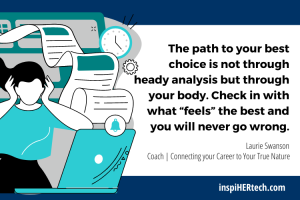I am working with a coaching client who has been getting ready to launch her job search. For a while now.
She was overwhelmed by the number of decisions she felt she needed to make in order to have a successful job search. And so she had done nothing at all.
Good old paralysis by analysis.
She was not sure if she should only apply for roles that used the tech stack she was comfortable with or if she should also apply to jobs using a different tech stack. Was that a waste of time? How would she get trained?
What about the industry? Did it make sense to go outside of her current industry? Would that help or harm her career?
What about the size of the company? What are the pros and cons of going with a F500 over a scaling startup?
In this next role, did she want a job that was hybrid, remote or fully onsite?
What about the timing of starting her search? She was on a big project that was set to go live in 16 weeks. Should she start her search now? Should she wait? If she waits, could she miss out on a great opportunity? Before the New Year or after?
What is the perfect number of jobs to apply for so that she was optimizing her time and getting the right amount of offers?
Whew! Exhausting, right? No wonder she felt stuck.
As I listened to her, I remembered a cool study done by Sheena Iyengar, Columbia University and Mark Lepper, Stanford University about jams. Yes, the kind you put on toast.
In their 2000 study, they looked at the assumption that people prefer to have a lot of choices when considering options.
In the study, they went to a supermarket and put out a display table of 24 jams on one typical day and a table of 6 jams on another similar day.
Then they tracked the number of sales. Did the people buy more jam when they had more choice or less?
The answer … LESS! In fact, 3% of the people stopped at the display of 24 jams purchased while almost 30% purchased from the display of 6 jams.
Fewer Choices Makes Decision Making Easier
How do you give yourself choice … but not too much?
The key to keeping overwhelm at a minimum and getting unstuck is to narrow your choices.
In order to do that you need to tune in to your body compass, that internal guiding light that knows what’s best for us even when our head thinks it can analyze its way to the best decision.
Try this:
Step 1: Start by putting all the options in priority order. You do not have to worry about how many places to apply to or what the tech stack needs to look like before you decide when you want to kick off your search. That is your first priority.
Step 2: Look at the number one priority in your search. In this case, when to start your search, and ask yourself what feels better? If you were to start your search before the New Year or after? Then go deeper. If it feels better to start before the end of the year, then ask yourself if it should be 2 weeks or 4? 4 weeks or 6? And so on until you have that feeling of “that’s it” in your gut.
Step 3: Now that you know you want to start your search in 10 weeks what is your next priority? Go back to Step 1.
We all want the path to where we are going next in our careers to be clear and easy. Because it doesn’t always work out that way the next best thing is to look at our options, prioritize them and then “feel” our way to the best choice for us.
Let’s make this simple. 2 choices: Sign up for a Career Strategy Session or One-on-one coaching. Simple as that!

